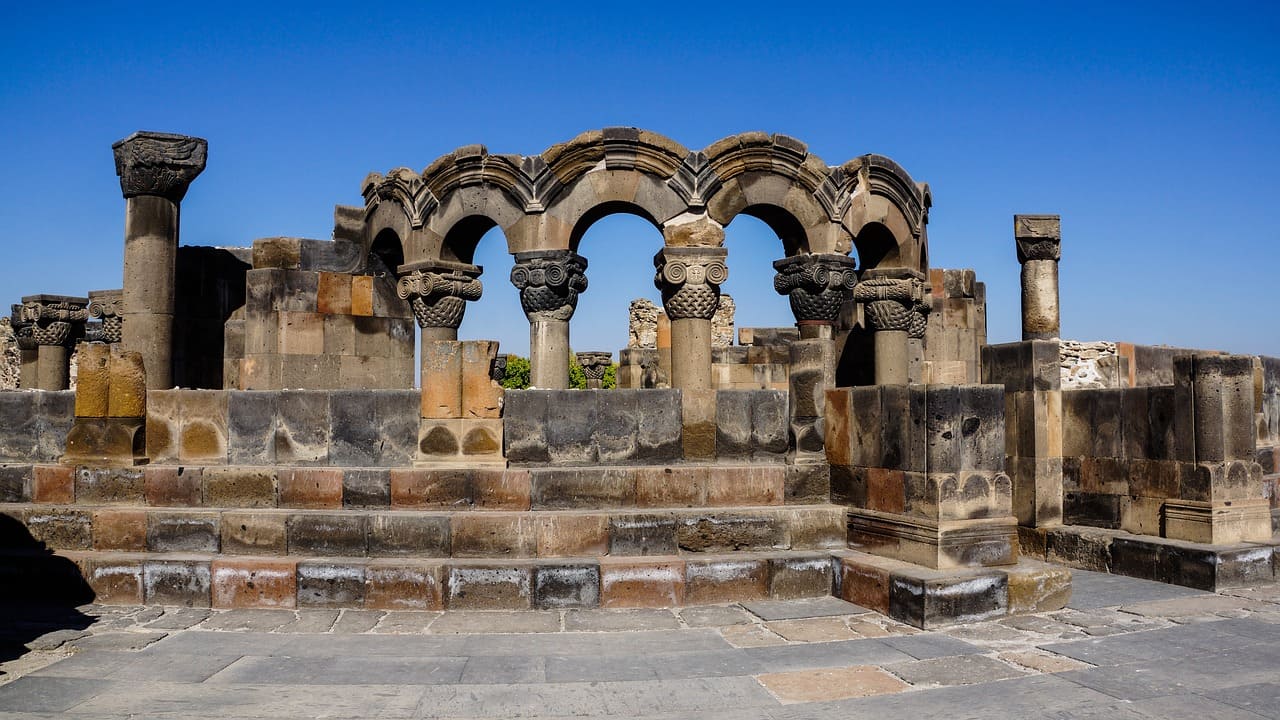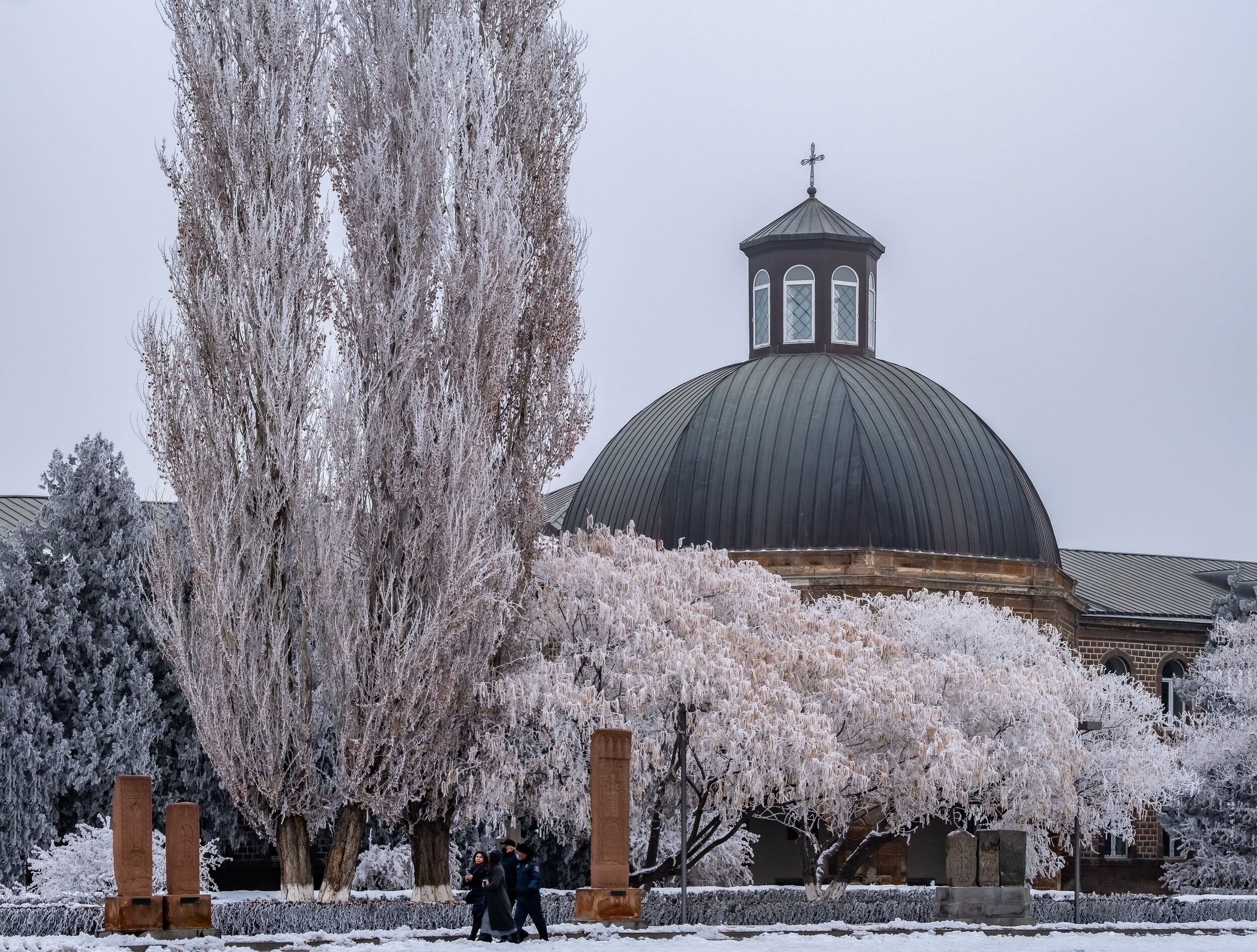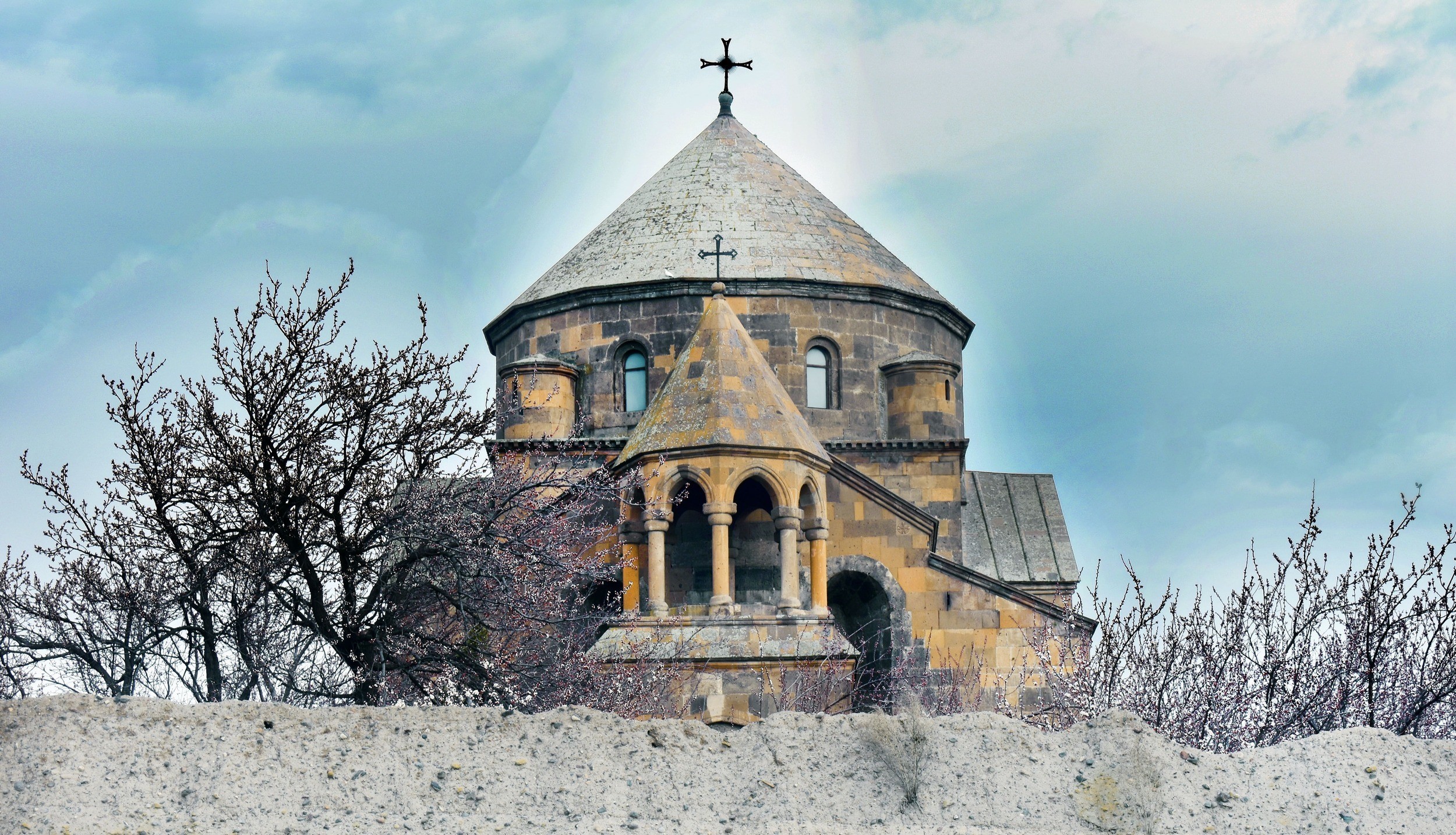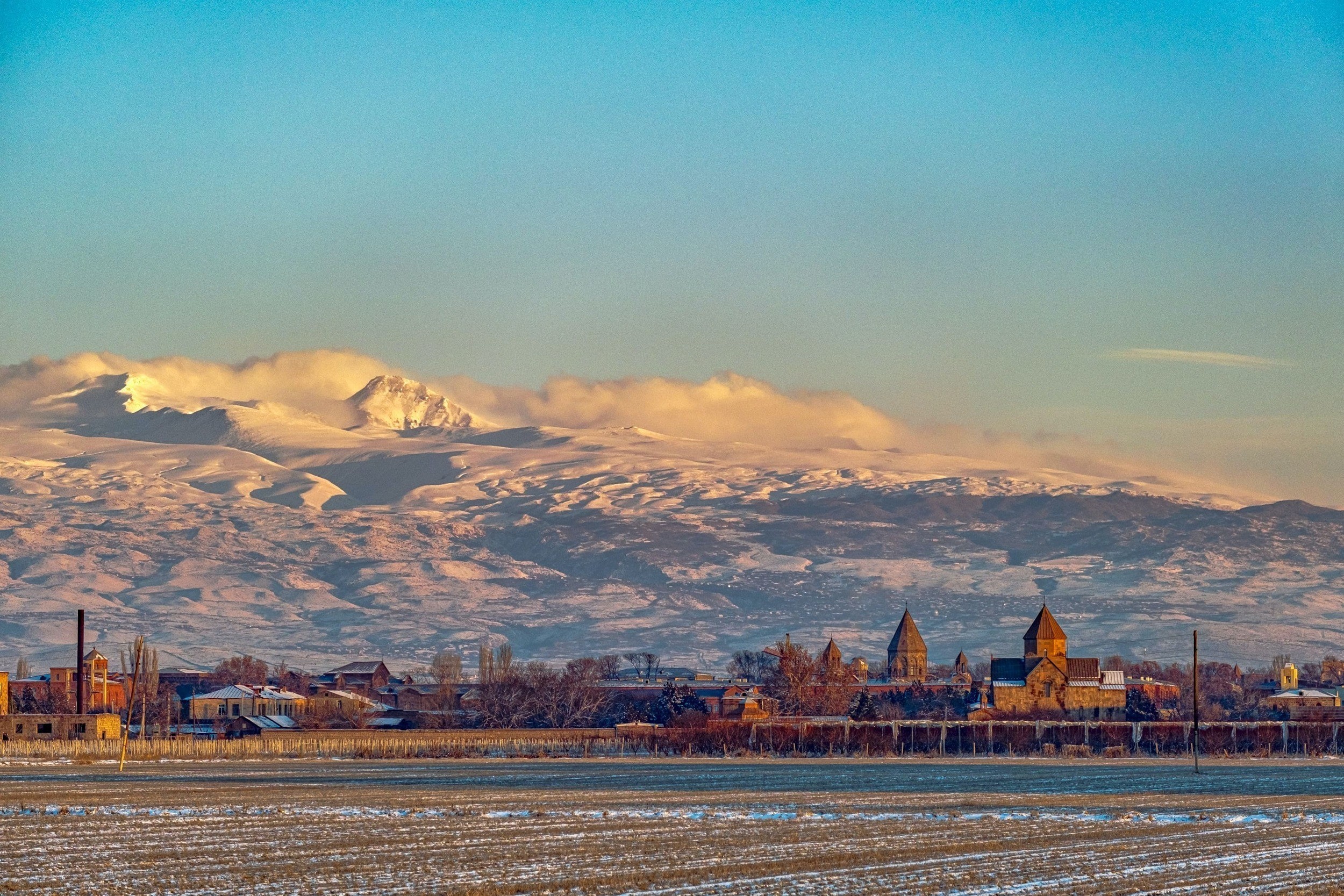Etchmiadzin is a city which the followers of the Armenian Apostolic Church strive to visit at least once in their life. The reason is: Etchmiadzin Cathedral, the first Christian church in Armenia and one of the oldest in the world is situated in this city.
Contents
- History of the city of Etchmiadzin: the past and the present
- How to get to the city?
- Things to do in and around Etchmiadzin
History of the city of Etchmiadzin: the past and the present
The territory of modern Etchmiadzin has been inhabited since prehistoric times. The name of the city has changed for several times. At first, the city was called Artimedes - in honor of the goddess Artemis or, as it is customary in Armenian mythology, Anahit. Then several rulers renamed the settlement in their honor. Prince Vardges Manuk named this place Vardgesavan. Then in the 140s AD King Vagharsh I came here and erected fortress walls, expanded the city, calling it Norakagak, the New City, which later became Vagharshapat.
In 168 AD Vagharshapat became the capital of Armenia and held this status until 335 AD. The most important event during this period was the construction of the first Christian church of Etchmiadzin in Vagharshapat in 301-303. It became a cathedral, the residence of the Catholicos. Since then, the people began to call the city of Vagharshapat Etchmiadzin, after the name of the cathedral.
The city did not stop developing as a spiritual and cultural center even after the loss of the status of the capital and the transfer of the residence of the Catholicos to Dvin. It was at the Etchmiadzin Monastery that the first repository of manuscripts in Armenia, a seminary, and an Armenian-language school appeared.
Vagharshapat was also an important trade point. It was densely populated, the inhabitants were engaged in various crafts, pottery and blacksmithing.
The city was repeatedly ruined when it passed into the power of the Persians, then the Turks, then the Mongols. But in peaceful times the rulers were restoring Vagharshapat, realizing the value of the Etchmiadzin monastery.
Etchmiadzin Cathedral again became the seat of the Catholicos in 1441 and has remained so ever since.
In the Soviet years, Vagharshapat was rebuilt under the leadership of the great Armenian architect Alexander Tamanyan, taking into account the relief and the oldest architectural monuments of the city. The buildings were oriented towards the mountains Ararat and Aragats. Being a cultural center, the city also became an industrial center with many factories. In addition, tourism was rapidly developing. From 1945 to 1992 Vagharshapat was officially called Etchmiadzin. After 1992 the city's former name was returned to it, however, both names are used today.
Modern Vagharshapat/Etchmiadzin can be called the spiritual capital of Armenia. Pilgrims and tourists from all over the country and the world visit the city to see the Etchmiadzin Monastery.
Industry is developed: there is a wine factory, as well as small wineries, a can factory and building materials plants. Local residents are actively engaged in agriculture. Climate contributes to it: it is hot in Etchmiadzin in summer. It is cold in winter, although not for a long time.

How to get to the city?
Echmiadzin is located in the Armavir region, just 20 km west of Yerevan. The journey by car or taxi takes 30 minutes. You can rent a car, for example, in Move2Car.
You can also take a bus: the bus No. 202 and fixed-route taxi No. 203 depart from the Kilikia Central Bus Station (Admiral Isakov Ave., 6). The fare is 300 and 250 AMD respectively.
There is also a railway station called "Echmiatsin", but it is located 15 km from the city. This is a less convenient travel option. The train follows the direction Yerevan - Araks - Yerevan and departs from the Central Railway Station (Tigran Mets Ave., 80). The ticket costs 300-400 AMD.
If you have any questions about your trip to Etchmiadzin, write to Move2Armenia support service - @move2armenia_official.
Things to do in and around Etchmiadzin
Temple of Zvartnots
On the way from Yerevan to Vagharshapat the Temple of Zvartnots is situated. It was built in 640-650 AD. Unfortunately, the basilica was destroyed during an earthquake in the 10th century, and it was discovered during excavations only in 1901–1907. Now the first tier of the temple is being reconstructed, the columns are well preserved. It is known that Zvartnots was so impressive that the Byzantine emperor Constant II wanted to build a similar one in his homeland.

Etchmiadzin Monastery Complex
The main reason why people come to Vagharshapat is the Etchmiadzin monastery, after which the city is often called. Pass to the territory of the monastery through a powerful arch, which depicts Tsar Trdat III and Gregory the Illuminator. Nearby there is an open altar, established in honor of the 1700th anniversary of the adoption of Christianity.
Once you appear in the territory of the monastery complex, look around. On the left you will see the first matenadaran in Armenia, a repository of ancient manuscripts. On the right there is the Gevorgyan Theological Seminary. Its famous graduates were Catholicos Gevorg VI, composer Komitas and writer A. Isahakyan.

Behind the seminary you can see the Church of st. Angels. It has a very unusual shape, resembling a drum to some, and a water tower to others. Inside it is spacious and full of light, you can see the reliefs of khachkars (cross-stones), and the light coming in from the windows in the form of crosses.

Let's return to the central alley decorated with khachkars. Let's walk past the printing house and monks'residence and we will see the very place from which the history of the monastery began. This is the Etchmiadzin Cathedral , the main spiritual center for Armenians, the main Armenian temple and the residence of the Catholicos of all Armenians. It was built after Christianity became a state religion in Armenia. The historian Agatangeghos wrote that Gregory the Illuminator saw a dream in which Jesus Christ pointed to the place where the temple should be built. The cathedral was called Etchmiadzin, which means “the Only Begotten descended,” and the altar was placed exactly where the hand of Christ was directed.
We talked about religion in Armenia in detail in this article. We also touched upon in what way Gregory the Illuminator is linked tto he establishment of Christianity in Armenia.
The cathedral was built on the site of a pagan temple, which was found during excavations in 1959. Some tourists manage to go down to the basement of the temple and look at the archaeological finds.
Initially, Etchmiadzin was a basilica, that is, it had a rectangular shape, and was made of wood. Over time, the cathedral was rebuilt, it became of a stone, cross-domed type. Etchmiadzin stands on a spring, and it fills the miraculous well inside the temple. Drinking fountains have been built in the territory of the monastery so that visitors can drink this healing water.
Most Armenian churches look ascetic, but the Echmiatsin cathedral is brightly painted, there are paintings with the images of saints, the Blessed Virgin Mary, Jesus Christ and Biblical scenes inside. In the eastern part of the cathedral the main relics of the Armenian Apostolic Church are kept: a particle of the Noah's ark, the holy spear (Geghard) Jesus Christ was pierced with,and the right hand of St. Gregory the Illuminator. More Christian relics are located behind the cathedral, in Treasury Museum of the Manukyans.

Unusual exhibits are stored in the Museum after Ruben Sevak. They tell the story of the writer Ruben Sevak and the entire Armenian intellectual class, who became the victims of the genocide in the early 20th century. The exposition consists of paintings by Western Armenian artists, as well as Ruben Sevak's personal belongings.
The monastery complex also includes a chapel, the residence of the Catholicos, a refectory and other religious buildings.
City churches
Armenia became Christian under King Trdat the III. While still a pagan, he brutally cracked down on Christian women who fled from Rome. The maiden Hripsime whom the king fell in love with but who refused him was among them. After the incident the king became seriously ill because the girls who died because of his orders did not leave his thoughts. He turned to Gregory, whom he kept in prison for his Christian faith. Gregory's prayers saved Trdat, he believed in God and proclaimed Armenia a Christian state in 301.
Many centuries later Churches of St. Hripsime, St. Gayane and St. Shoghakat were erected in Vagharshapat. They are located at the places where St. Hripsime, St. Gayane and 38 nuns who followed them from Rome were killed.
Not far from the monastery Surb Astvatsatsin Church (Holy Mother of God) is situated. Until 2014, it served as the residence of the head of the Armavir diocese of the Armenian Apostolic Church. Together with other churches of Vagharshapat, the Cathedral and the Temple of Zvartnots, this temple is included in the UNESCO World Heritage List.
City museums
In addition to those located on the territory of the monastery, there are several other museums in Vagharshapat. The main is the Historical and Ethnographic Museum. It contains about 15,000 exhibits, the most important of which is a printing press machine made in 1809. It was presented to Catholicos Mkrtich I by Queen Victoria of Great Britain.
The House-museum of the poet Hovhannes Hovhannisyanis located in the very center of the city. You can see how the man who is called the founder of classical Armenian poetry lived there.
In 1990 Museum of Mher Abeghyanopened. The artist bequeathed his paintings to his native city which formed the base of the museum exposition. Mher Abeghyan mastered many artistic techniques, therefore, it is interesting to compare his paintings to determine which technique prevailed in one or another period of the artist's life.
Gallery of Khoren Ter-Harutyunyan is located in the former building of the Echmiatsin cinema. More than 200 works by the Armenian-American sculptor and artist, the author of the “Reborn Armenia” monument in Yeritasardutyan Park in Yerevan are exhibited in this gallery.
After walking around the city you can go to "Machanents" restaurant. Tourists can have a rest and continue to get to know the Armenian culture there. The restaurant serves national dishes. An art gallery operates nearby where workshops are held. The interior of the restaurant is made up of antique pieces of furniture. If travelers plan to explore Vagharshapat for more than one day they can also stay in a guest house here.
Etchmiatsin is the right place for a weekend getaway as it is close to Yerevan. We suggest visiting a few more cities close to the capital like Masis and Artashat. You can get to know Armenia even by exploring the suburbs of Yerevan. And you can do this with tourist offices or private guides, the lists can be found in the Move2Armenia directory.















Add a comment